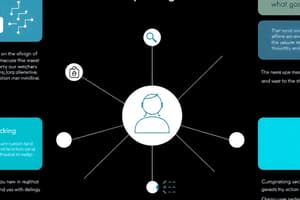Podcast
Questions and Answers
What is the primary goal of needfinding in interface design?
What is the primary goal of needfinding in interface design?
- Creating aesthetic designs
- Identifying technological advancements
- Finding potential user needs (correct)
- Simplifying design processes
Which of the following represents a main needfinding question?
Which of the following represents a main needfinding question?
- What improvements do developers want?
- What technology will be used?
- What do users need? (correct)
- How should the interface look?
Why is it important to categorize users in the needfinding process?
Why is it important to categorize users in the needfinding process?
- To create a generic user profile for designers
- To increase sales and marketing strategies
- To minimize user feedback
- To understand different user requirements and contexts (correct)
Who is typically NOT considered a representative user?
Who is typically NOT considered a representative user?
What is an essential aspect to consider when identifying user needs?
What is an essential aspect to consider when identifying user needs?
What is the primary goal of ethnographic observation?
What is the primary goal of ethnographic observation?
Which method involves creating detailed descriptions of hypothetical users?
Which method involves creating detailed descriptions of hypothetical users?
What action is NOT recommended when conducting observational studies?
What action is NOT recommended when conducting observational studies?
What technique can help in understanding users' real behaviors and pain points?
What technique can help in understanding users' real behaviors and pain points?
What is a common risk associated with ethnographic observation?
What is a common risk associated with ethnographic observation?
What type of questions are suggested for easier processing?
What type of questions are suggested for easier processing?
Which type of question is likely to solicit more comments?
Which type of question is likely to solicit more comments?
What should be avoided when asking about a feature's importance?
What should be avoided when asking about a feature's importance?
What follow-up method is recommended after quantitative questions?
What follow-up method is recommended after quantitative questions?
What is a characteristic of a bad question to avoid?
What is a characteristic of a bad question to avoid?
What is the main difference between process and practice in observation?
What is the main difference between process and practice in observation?
What is a characteristic of controlled observation?
What is a characteristic of controlled observation?
Why is naturalistic observation considered more reliable than controlled observation?
Why is naturalistic observation considered more reliable than controlled observation?
What typically influences the activities and goals of individuals in an observational context?
What typically influences the activities and goals of individuals in an observational context?
What is often a key component of tacit knowledge?
What is often a key component of tacit knowledge?
Flashcards
Needfinding
Needfinding
The process of identifying and understanding user needs, wants, and the context in which they are using a system.
User Categories
User Categories
The unique characteristics and qualities of the people who will use the system being designed.
Designers Are Not Users
Designers Are Not Users
The designers and developers of a system should not assume they represent the typical user, as their skills, knowledge, and background may be different.
Clients Are Not Users
Clients Are Not Users
Signup and view all the flashcards
Context of Use
Context of Use
Signup and view all the flashcards
Ethnographic Observation
Ethnographic Observation
Signup and view all the flashcards
Surveys
Surveys
Signup and view all the flashcards
Interviews
Interviews
Signup and view all the flashcards
Focus Groups
Focus Groups
Signup and view all the flashcards
User Artifact Analysis
User Artifact Analysis
Signup and view all the flashcards
Tacit Knowledge
Tacit Knowledge
Signup and view all the flashcards
Controlled Observation
Controlled Observation
Signup and view all the flashcards
Naturalistic Observation
Naturalistic Observation
Signup and view all the flashcards
Process
Process
Signup and view all the flashcards
Practice
Practice
Signup and view all the flashcards
Closed questions
Closed questions
Signup and view all the flashcards
Open-ended questions
Open-ended questions
Signup and view all the flashcards
Quantitative questions
Quantitative questions
Signup and view all the flashcards
Direct, concrete, specific
Direct, concrete, specific
Signup and view all the flashcards
Use the user’s language
Use the user’s language
Signup and view all the flashcards
Study Notes
Interface Design - ITD34003
- Chapter 3 is about identifying needs and establishing requirements, also known as "Needfinding."
- The goals of this chapter are: understanding system requirements and user needs, and learning tools and instruments for needfinding.
- A human-centered design process exists with stages including Understanding User Needs, analysis techniques, design & prototyping, and implementing and deploying.
- Needfinding is the process of uncovering potential user needs.
- Needfinding questions include: what users need, what users want, who the users are, how users are currently doing things, the context in which users operate,and whether simply asking users is sufficient.
Know Your Users
- Understanding who uses the system is important to good design.
- Users can vary by demographics (age, experience, and technical background).
- Designers should not assume that they understand the users.
- It is crucial to talk to real users, not just industry experts.
- Techniques for identifying user needs include surveys, interviews, direct involvement (participatory design), observation, and imagining (personas).
Needfinding Methods
- Techniques adopted in needfinding and requirement analysis include: observation, ethnographic research, surveys, interviews, and focus groups.
Observation
- Observation is a valuable tool and can often reveal a lot about how users are operating, including their workflows.
- There are different types of observations, including controlled and naturalistic, with various strengths and weaknesses.
- Ethical considerations and considerations for user privacy are key to observations. Observations may impact behavior and therefore, disrupting their daily activities should be minimized.
- It is important to understand what and how to observe, and what can be learned from observation (e.g. practices and processes, and especially tacit knowledge).
- One should strive to understand the context of how people work.
Ethnographic Considerations
- Ethnographic observation is an important research technique.
- The technique focuses on immersing oneself in the users' environment to better understand their habits and behaviors.
- It aims to understand the necessary data to inform the design of the system.
Interviewing
- Interviewing is about asking questions and listening to the responses to learn about user needs and desires.
- Different types of interviews (i.e. structured and unstructured) exist.
- Qualitative and quantitative data can be collected via interviews.
- Open-ended questions that allow for more insight and understanding are often better than closed-ended questions.
- Structured questions are easier to process, while unstructured questions solicit more comments.
- Avoid leading questions as these might bias the results.
Survey Considerations
- Surveys are a fast and cost-effective method for gathering data from a variety of people.
- Results from surveys can be easily visualized and analyzed.
- Survey questions must be carefully constructed and include a clear purpose and expected timeframe.
- Surveys work best as a shallow look into a large group, but are inappropriate as a deep-dive into a niche.
Types of Questions
- Open-ended questions encourage more detailed answers.
- Closed-ended questions restrict responses to specific options. (e.g. 1 to 5 rating scale)
- Ordinal scales, likert scales or nominal scales can be used.
Data Collection
- Data from observations (both objective and subjective) and interviews are important.
- Data may include impressions, rankings, summary reports, workplace artifacts, anecdotal data, and critical incidents.
Measurement Scales
- There are different types including Nominal, Ordinal, Interval and Ratio.
- Different statistics can be used to represent the data collected. (e.g. Counting, frequency, mean, mode, median etc.)
Warning Points
- Avoid complex questions if simpler ones will suffice.
- Avoid using negative phrasing in questions, as these can lead to biased answers.
- Avoid biased questions that might bias the results.
Summary
- Gathering requirements is essential to a successful product.
- Multiple techniques and types of questions can be used to collect data on users.
Studying That Suits You
Use AI to generate personalized quizzes and flashcards to suit your learning preferences.
Related Documents
Description
This quiz focuses on Chapter 3 of Interface Design, which covers the essential process of identifying user needs and establishing requirements. Students will explore the human-centered design process and learn important techniques for effective needfinding to enhance system design. Understanding the context and demographics of users is emphasized.


